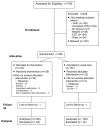Influence of a symptom management telehealth intervention on older adults' early recovery outcomes after coronary artery bypass surgery
- PMID: 19755186
- PMCID: PMC2900787
- DOI: 10.1016/j.hrtlng.2009.01.005
Influence of a symptom management telehealth intervention on older adults' early recovery outcomes after coronary artery bypass surgery
Abstract
Objective: The study objective was to examine the effect of a symptom management (SM) telehealth intervention on physical activity and functioning and to describe the health care use of older adult patients (aged > 65 years) after coronary artery bypass surgery (CABS) by group (SM intervention group and usual care group).
Methods: A randomized clinical trial design was used. The study was conducted in 4 Midwestern tertiary hospitals. The 6-week SM telehealth intervention was delivered by the Health Buddy (Health Hero Network, Palo Alto, CA). Measures included Modified 7-Day Activity Interview, RT3 accelerometer (Stayhealthy, Inc, Monrovia, CA), physical activity and exercise diary, Medical Outcomes Study Short-Form 36, and subjects' self-report and provider records of health care use. Follow-up times were 3 and 6 weeks and 3 and 6 months after CABS.
Results: Subjects (N = 232) had a mean age of 71.2 (+4.7) years. There were no significant interactions using repeated-measures analyses of covariance. There was a significant group effect for average kilocalories/kilogram/day of estimated energy expenditure as measured by the RT3 accelerometer, with the usual care group having a higher estimated energy expenditure. Both groups had significant improvements over time for role-physical, vitality, and mental functioning. Both groups had similar health care use.
Conclusion: Subjects were able to return to preoperative levels of functioning between 3 and 6 months after CABS and to increase their physical activity over reported preoperative levels of activity. Further study of those patients undergoing CABS who could derive the most benefit from the SM intervention is warranted.
References
-
- Barnason S, Zimmerman L, Anderson A, Mohr-Burt S, Nieveen J. Functional status outcomes of patients with a coronary artery bypass graft over time. Heart & Lung. 2000;29(1):33–46. - PubMed
-
- Hunt JO, Hendrata MV, Myles PS. Quality of life 12 months after coronary artery bypass graft surgery. Heart Lung. 2000;29(6):401–411. - PubMed
-
- Ross AC, Ostrow L. Subjectively perceived quality of life after coronary artery bypass graft surgery. American Journal of Critical Care. 2001;10:11–16. - PubMed
-
- Zimmerman L, Barnason S, Brey BA, Catlin S, Nieveen J. Comparison of recovery patterns for patients undergoing coronary artery bypass grafting and minimally invasive direct coronary artery bypass in the early discharge period. Prog Cardiovasc Nurs. 2002;17(3):132–141. - PubMed
-
- Barnason S, Zimmerman L, Nieveen J, et al. Usefulness of RISKO heart hazard appraisal to quantify CAD risk factor burden on the preoperative functioning of coronary artery bypass graft surgery patients. Prog Cardiovasc Nurs. 2007;22(2):81–87. - PubMed


